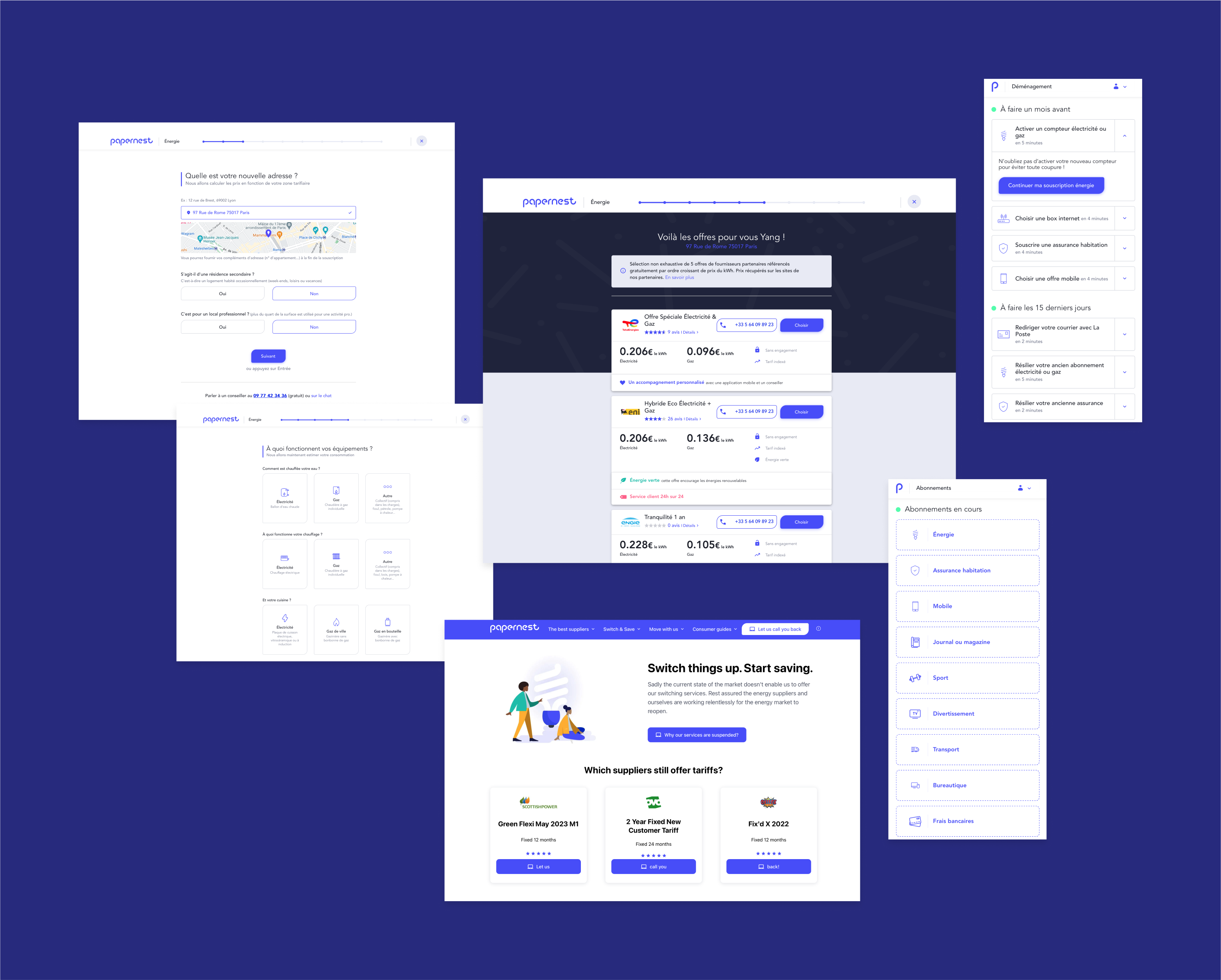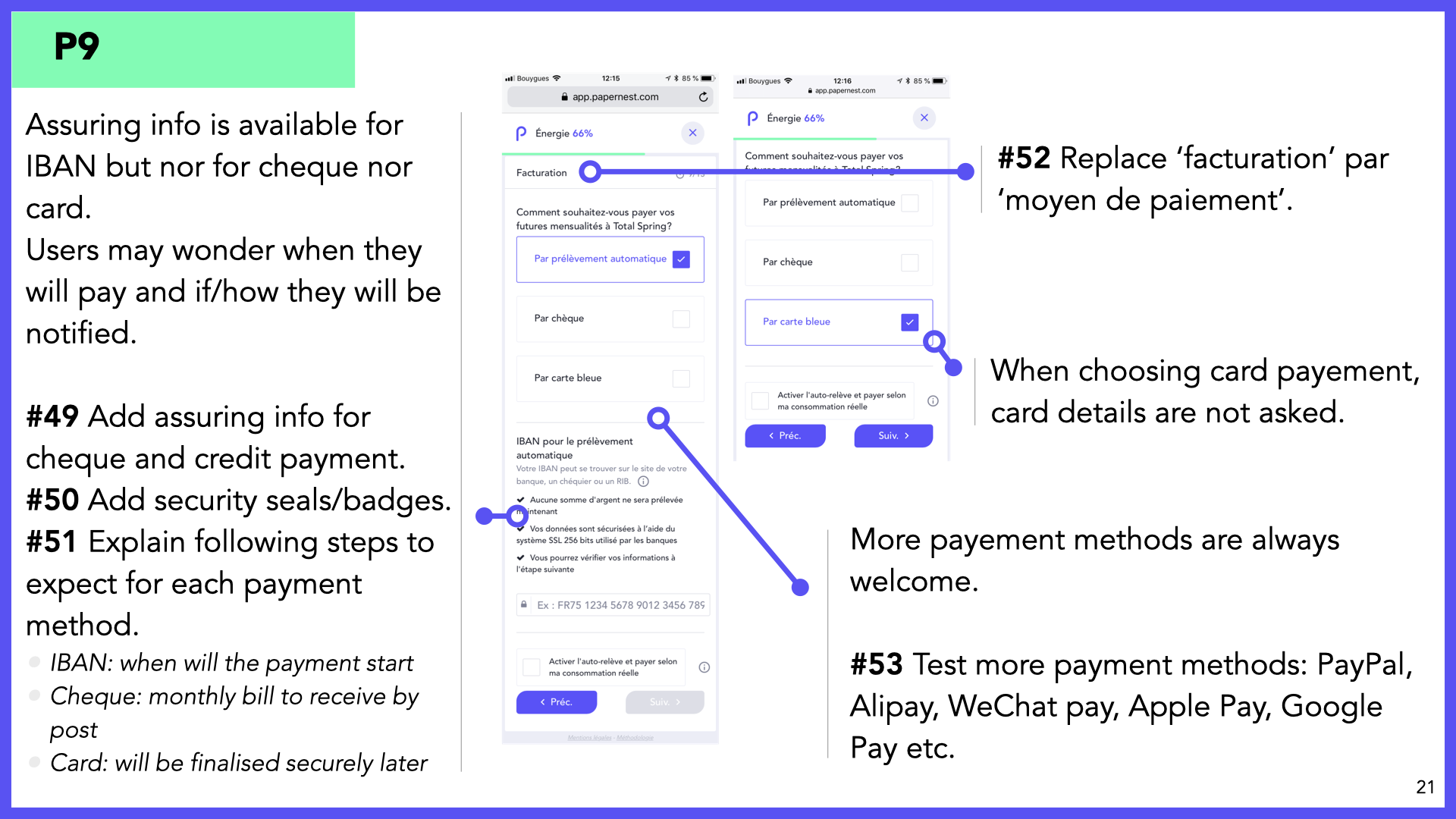Leadership, Product Management, Product Design
Papernest Product Portfolio
![]()

MISSION
Upon joining Papernest, a pioneering contract management start-up at its third year of inception, I undertook a transformative mission as the Chief Product Officer. My objective was to spearhead the expansion and cultivation of a team comprised of highly motivated junior to mid-level product managers and designers, propelling the evolution of Papernest's diverse product portfolio.
This multifaceted challenge encompassed several key facets. First, I directed the refinement of a B2C web application, focusing on optimising its key funnel for higher conversion rate. Simultaneously, I orchestrated the lean and cost-effective inception and development of a ground-up B2B product, harnessing innovation to craft a compelling and resource-efficient offering.
In addition, I assumed responsibility for overseeing a diverse array of acquisition assets, nurturing their growth with our acquisition squad and the marketing crew. The emphasis on SEO and SEA excellence emerged as a pivotal driving force behind Papernest's success.
Furthermore, I led an Operations squad skilled in Salesforce integration, ensuring seamless cohesion across the product spectrum. This entailed ongoing flow optimisation to boost operational efficiency, solidifying Papernest's industry leadership.
This multifaceted challenge encompassed several key facets. First, I directed the refinement of a B2C web application, focusing on optimising its key funnel for higher conversion rate. Simultaneously, I orchestrated the lean and cost-effective inception and development of a ground-up B2B product, harnessing innovation to craft a compelling and resource-efficient offering.
In addition, I assumed responsibility for overseeing a diverse array of acquisition assets, nurturing their growth with our acquisition squad and the marketing crew. The emphasis on SEO and SEA excellence emerged as a pivotal driving force behind Papernest's success.
Furthermore, I led an Operations squad skilled in Salesforce integration, ensuring seamless cohesion across the product spectrum. This entailed ongoing flow optimisation to boost operational efficiency, solidifying Papernest's industry leadership.
PROCESS
In a dynamic team structure encompassing four distinct squads—B2C, B2B, Acquisition, and Operations—the product design process is thoughtfully tailored to accommodate the unique challenges presented by each group. While varying problem sets, objectives, team compositions, tech stacks, and agile methodologies exist, a resolute outcome-driven mindset is woven into the fabric of our approach, ensuring that the entire product team engages in product discovery with an unwavering commitment to user-centricity and data-driven decision-making.
In this complex team setup, the product design process harmoniously combines tailored approaches and unified principles, facilitating an efficient journey to create exceptional user-centered, data-driven products.
- Adaptable Framework and Outcome Focus: Acknowledging the diverse needs of each squad, the product design process is meticulously adapted to address specific requirements. The focus remains resolutely on tangible outcomes, aligning problem-solving methods, objectives, and technology choices accordingly.
- Unified Mindset: Irrespective of the squad's focus, a user-centric and data-driven mindset serves as the cornerstone of the entire product team's approach. This ensures that user needs remain central to every decision, while data insights drive iterative improvements.
- Cross-Squad Collaboration: Despite the unique challenges faced by each squad, a culture of collaboration is fostered. Regular cross-squad interactions and knowledge sharing sessions facilitate a holistic understanding of the product ecosystem, promoting innovative solutions and preventing silos.
- User Research Integration: Each squad integrates user research as an essential component of their respective product design processes. This entails collecting user feedback, conducting usability tests, and leveraging analytics to drive informed decisions.
- Iterative Testing and Feedback Loops: Continuous feedback loops are established, enabling iterative testing and refinement of prototypes, designs, and features. This iterative approach thrives on learning from user interactions and adapting solutions accordingly.
- Regular Sync-ups and Design Reviews: Scheduled cross-squad sync-ups not only provide a platform for discussing challenges, sharing insights, and aligning strategies but also include dedicated design review sessions. These collaborative gatherings foster an environment of creativity and innovation, reducing knowledge gaps, enhancing overall coordination, and ensuring that design considerations remain integral to our outcome-driven approach.
- KPI Alignment and Transparency: Collaboratively defined key performance metrics ensure consistent success criteria across squads, enabling meaningful comparisons and informed decisions. These KPIs are regularly communicated throughout the company, fostering team accountability and reinforcing our outcome-driven approach.
- Documentation and Knowledge Sharing: Best practices, lessons learned, and successful strategies are documented and shared across squads. This knowledge repository serves as a valuable resource, aiding in efficient problem-solving and solution development.
- Continuous Learning Culture: A commitment to continuous learning is nurtured, encouraging team members to explore new tools, methodologies, and industry trends. This proactive approach enriches the team's skillset and maintains a culture of innovation.
In this complex team setup, the product design process harmoniously combines tailored approaches and unified principles, facilitating an efficient journey to create exceptional user-centered, data-driven products.



B2C Web App Conversion Funnel Optimisation Opportunities
OUTCOME
Improved B2C app funnel conversion rate by 30% with an NPS at 60 high through 60+ AB tests in 10 months.
Built the B2B app and grew B2B revenue by 500% and increased 3-month retention by 25% with an NPS at 50 high.
Ensured Papernest’s leading on-line Acquisition position against competition.
Reduced main subscription flow Operations time by 20%.
Built the B2B app and grew B2B revenue by 500% and increased 3-month retention by 25% with an NPS at 50 high.
Ensured Papernest’s leading on-line Acquisition position against competition.
Reduced main subscription flow Operations time by 20%.